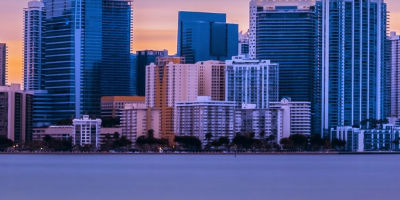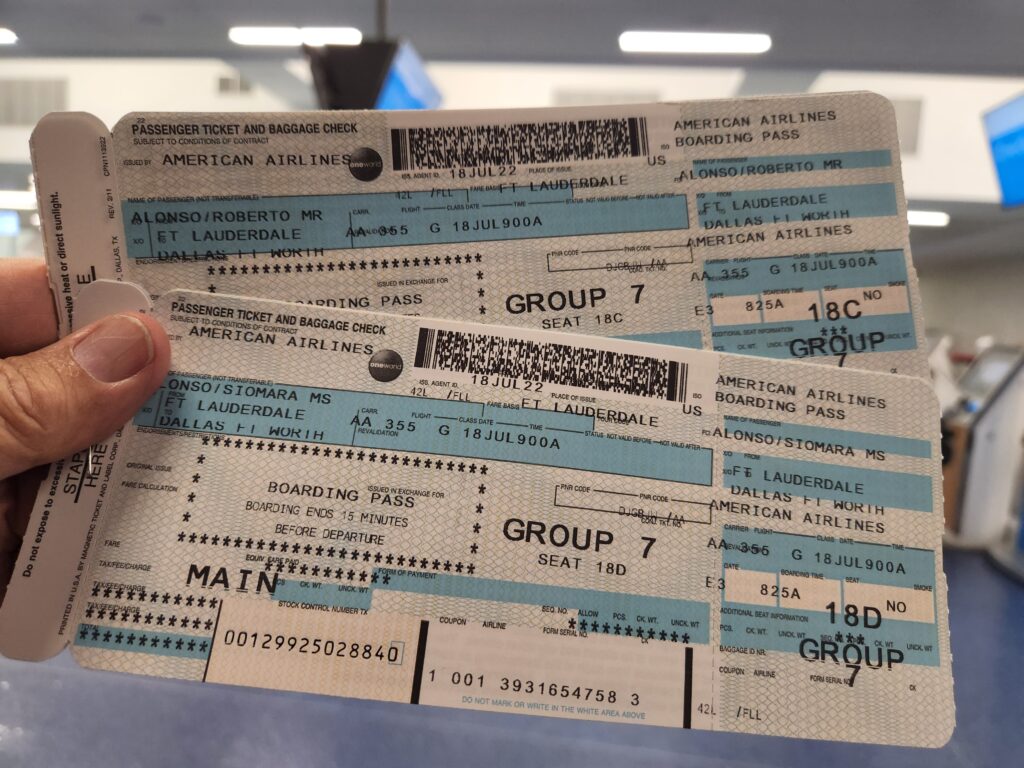
Bloody Mary
A Bloody Mary is a cocktail containing vodka, tomato juice, and other spices and flavorings including Worcestershire sauce, hot sauces, garlic, herbs, horseradish, celery, olives, pickled vegetables, salt, black pepper, lemon juice, lime juice and celery salt. Some versions of the drink, such as the “surf ‘n turf” Bloody Mary, include shrimp and bacon as garnishes. In the United States, it is usually consumed in the morning or early afternoon and is popular as a hangover cure. The Bloody Mary was invented in the 1920s or 1930s. There are various theories as to the origin of the drink and its name. It has many variants, most notably the Red Snapper (also called Bloody Margaret), the Virgin Mary, the Caesar, and the Michelada.

A321EOW
The Airbus A321 is a member of the Airbus A320 family of short to medium range, narrow-body, commercial passenger twin engine jet airliners; it carries 185 to 236 passengers. It has a stretched fuselage which was the first derivative of the baseline A320 and entered service in 1994, about six years after the original A320. The aircraft shares a common type rating with all other Airbus A320-family variants, allowing previous A320-family pilots to fly the aircraft without the need for further training.
In December 2010, Airbus announced a new generation of the A320 family, the A320neo (new engine option). The similarly lengthened fuselage A321neo variant offers new, more efficient engines, combined with airframe improvements and the addition of winglets (called Sharklets by Airbus). The aircraft delivers fuel savings of up to 15%. The A321neo carries up to 244 passengers, with a maximum range of 4,000 nmi (7,400 km) for the long-range version when carrying no more than 206 passengers.
Final assembly of the aircraft takes place in Hamburg, Germany, or Mobile, USA. As of December 2021, a total of 2,451 A321 airliners have been delivered, of which 2,404 are in service. In addition, another 3,419 aircraft are on firm order (comprising 7 A321ceo and 3,412 A321neo). American Airlines is the largest operator of the Airbus A321 with 262 airplanes in its fleet.
x
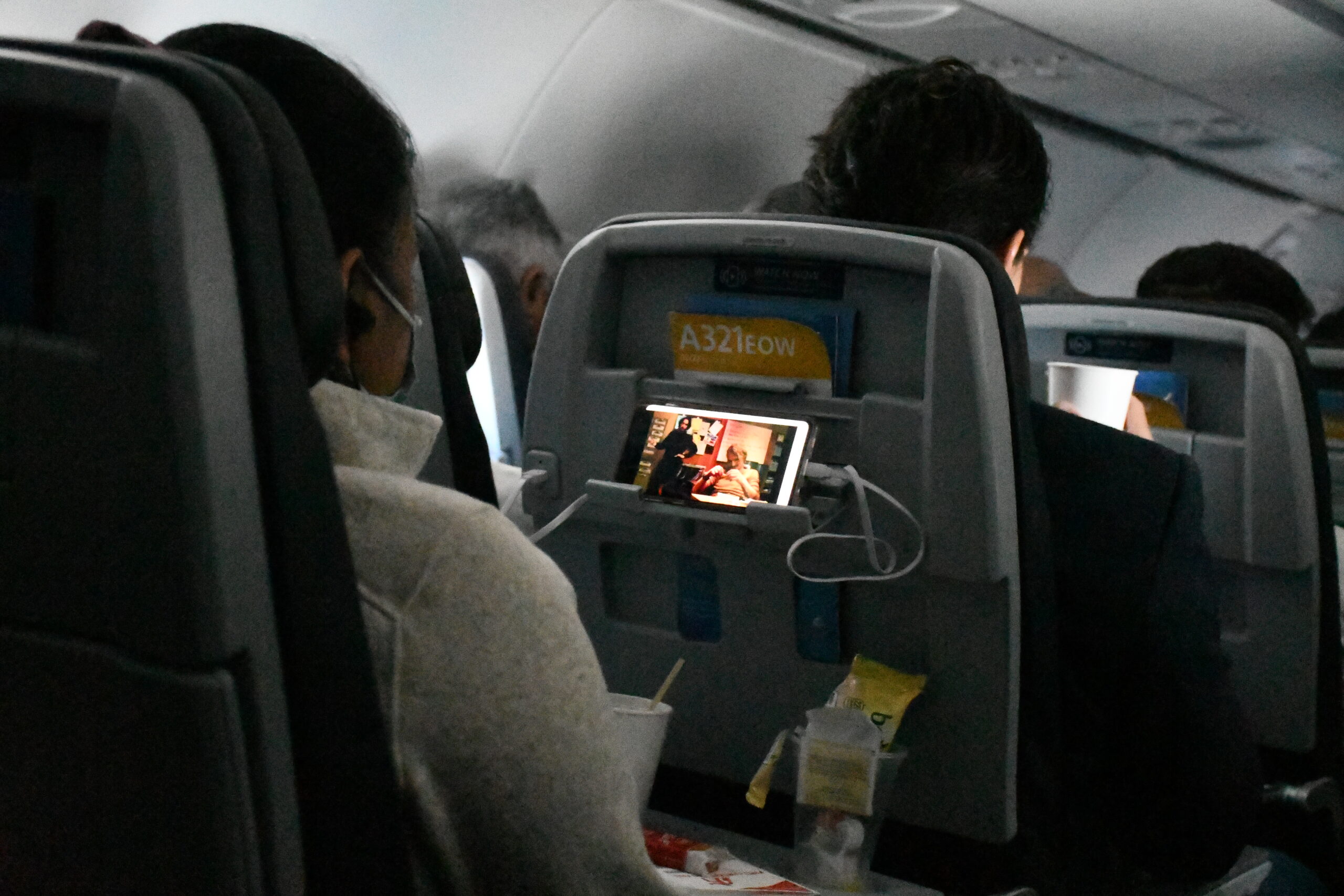
x
El Airbus A321 es un miembro de la familia Airbus A320 de aviones a reacción bimotores comerciales de corto a mediano alcance, cuerpo estrecho y pasajeros; transporta de 185 a 236 pasajeros. Tiene un fuselaje estirado que fue el primer derivado del A320 de referencia y entró en servicio en 1994, unos seis años después del A320 original. El avión comparte una clasificación de tipo común con todas las demás variantes de la familia Airbus A320, lo que permite a los pilotos anteriores de la familia A320 volar el avión sin la necesidad de capacitación adicional.
En diciembre de 2010, Airbus anunció una nueva generación de la familia A320, el A320neo (nueva opción de motor). La variante A321neo del fuselaje alargada de manera similar ofrece motores nuevos y más eficientes, combinados con mejoras en el fuselaje y la adición de winglets (llamados Sharklets por Airbus). El avión ofrece un ahorro de combustible de hasta el 15%. El A321neo transporta hasta 244 pasajeros, con un alcance máximo de 4.000 nmi (7.400 km) para la versión de largo alcance cuando no transporta más de 206 pasajeros.
El montaje final de la aeronave tiene lugar en Hamburgo, Alemania, o Mobile, EE. UU. A diciembre de 2021, se han entregado un total de 2.451 aviones A321, de los cuales 2.404 están en servicio. Además, otros 3.419 aviones están en orden firme (que comprende 7 A321ceo y 3.412 A321neo). American Airlines es el mayor operador del Airbus A321 con 262 aviones en su flota.
The City
Kennedy Memorial

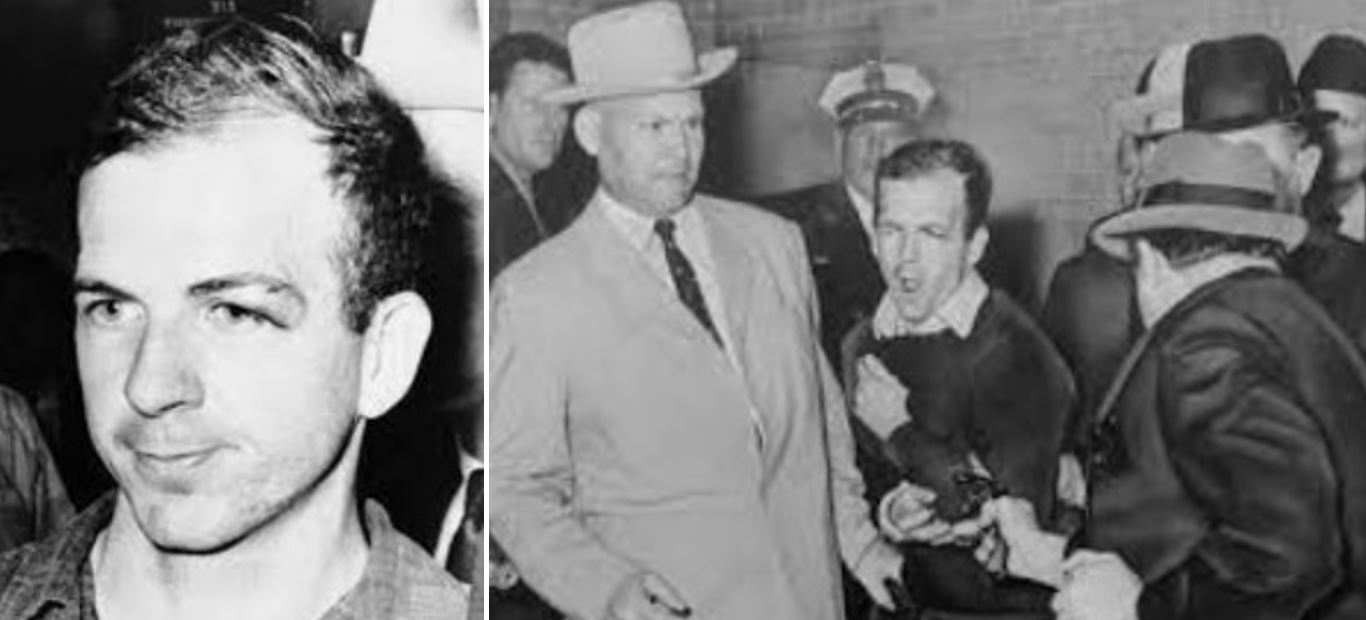
Lee Harvey Oswald (October 18, 1939 – November 24, 1963) was a U.S. Marine veteran who supposedly assassinated John F. Kennedy, then president of the United States, on November 22, 1963.
Lee Harvey Oswald (18 de octubre de 1939 – 24 de noviembre de 1963) fue un veterano de la Marina de los Estados Unidos quien supuestamente asesinó a John F. Kennedy, entonces presidente de los Estados Unidos, el 22 de noviembre de 1963.
x
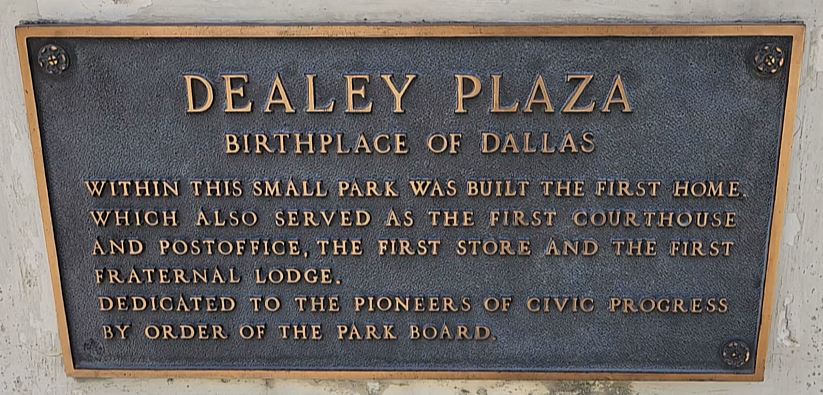
x
Oswald was placed in juvenile detention at the age of 12 for truancy, during which time he was assessed by a psychiatrist as “emotionally disturbed”, due to a lack of normal family life. After attending 12 schools in his youth, he quit repeatedly, and finally when he was 17, joined the Marines. Oswald was court-martialed twice while in the Marines, and jailed. He was honorably released from active duty in the Marine Corps into the reserve, then promptly flew to Europe and defected to the Soviet Union in October 1959. He lived in Minsk, Byelorussia, married a Russian woman named Marina, and had a daughter. In June 1962, he returned to the United States with his wife, and eventually settled in Dallas, where their second daughter was also born.
x
x
According to Lyndon B. Johnson, it was Castro who had Kennedy killed.
De acuerdo con Lyndon B. Johnson, fue Castro quien mandó a eliminar a Kennedy.
x
Oswald fue puesto en detención juvenil a la edad de 12 años por ausentismo escolar, tiempo durante el cual fue evaluado por un psiquiatra como “emocionalmente perturbado”, debido a la falta de una vida familiar normal. Después de asistir a 12 escuelas en su juventud, renunció repetidamente y finalmente cuando tenía 17 años, se unió a los Marines. Oswald fue sometido a consejo de guerra dos veces mientras estaba en los Marines y encarcelado. Fue liberado honorablemente del servicio activo en el Cuerpo de Marines a la reserva, luego voló rápidamente a Europa y desertó a la Unión Soviética en octubre de 1959. Vivió en Minsk, Bielorrusia, se casó con una mujer rusa llamada Marina y tuvo una hija. En junio de 1962, regresó a los Estados Unidos con su esposa, y finalmente se estableció en Dallas, donde también nació su segunda hija.
Oswald supposedly shot and killed Kennedy on November 22, 1963, from a sixth-floor window of the Texas School Book Depository as Kennedy traveled by motorcade through Dealey Plaza in Dallas. About 45 minutes after assassinating Kennedy, Oswald shot and killed Dallas police officer J. D. Tippit on a local street. He then slipped into a movie theater, where he was arrested for Tippit’s murder. Oswald was charged with the assassination of Kennedy, but he denied responsibility for the killing, claiming that he was a “patsy“. Two days later, Oswald was fatally shot by local nightclub owner Jack Ruby on live television in the basement of Dallas Police Headquarters.
x
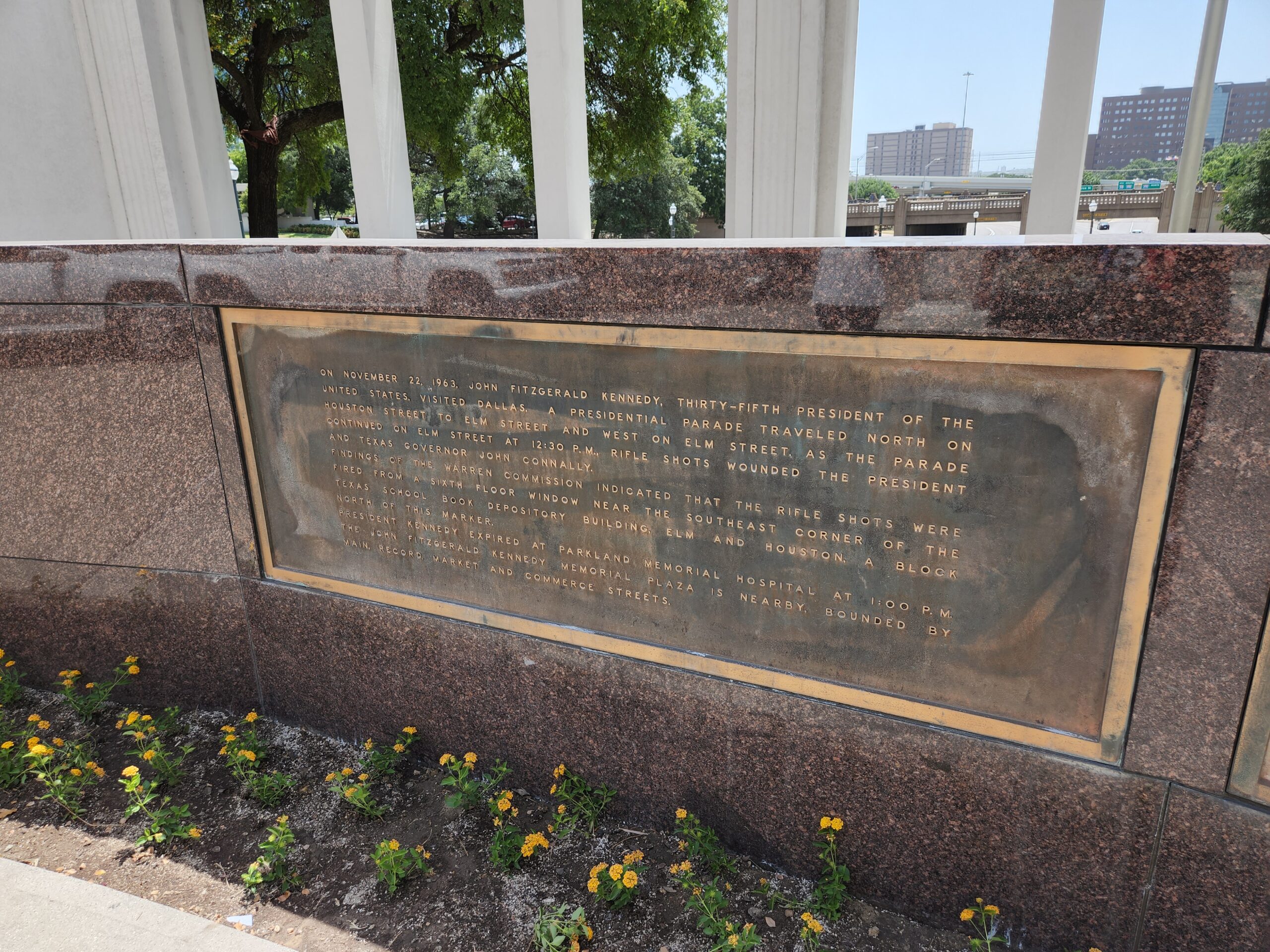
x
Oswald supuestamente disparó y mató a Kennedy el 22 de noviembre de 1963, desde una ventana del sexto piso del Texas School Book Depository mientras Kennedy viajaba en caravana a través de Dealey Plaza en Dallas. Unos 45 minutos después de asesinar a Kennedy, Oswald disparó y mató al oficial de policía de Dallas J. D. Tippit en una calle local. Luego se coló en una sala de cine, donde fue arrestado por el asesinato de Tippit. Oswald fue acusado del asesinato de Kennedy, pero negó su responsabilidad en el asesinato, alegando que era un “chivo expiatorio”. Dos días después, Oswald fue asesinado a tiros por el dueño de un club nocturno local Jack Ruby en la televisión en vivo en el sótano de la sede de la policía de Dallas.
In September 1964, the Warren Commission concluded that Oswald had acted alone when assassinating Kennedy. This conclusion, though controversial, was supported by investigations from the Dallas Police Department, the Federal Bureau of Investigation (FBI), the United States Secret Service, and the House Select Committee on Assassinations.
En septiembre de 1964, la Comisión Warren concluyó que Oswald había actuado solo al asesinar a Kennedy. Esta conclusión, aunque controvertida, fue respaldada por investigaciones del Departamento de Policía de Dallas, la Oficina Federal de Investigaciones (FBI), el Servicio Secreto de los Estados Unidos y el Comité Selecto de Asesinatos de la Cámara de Representantes.
x
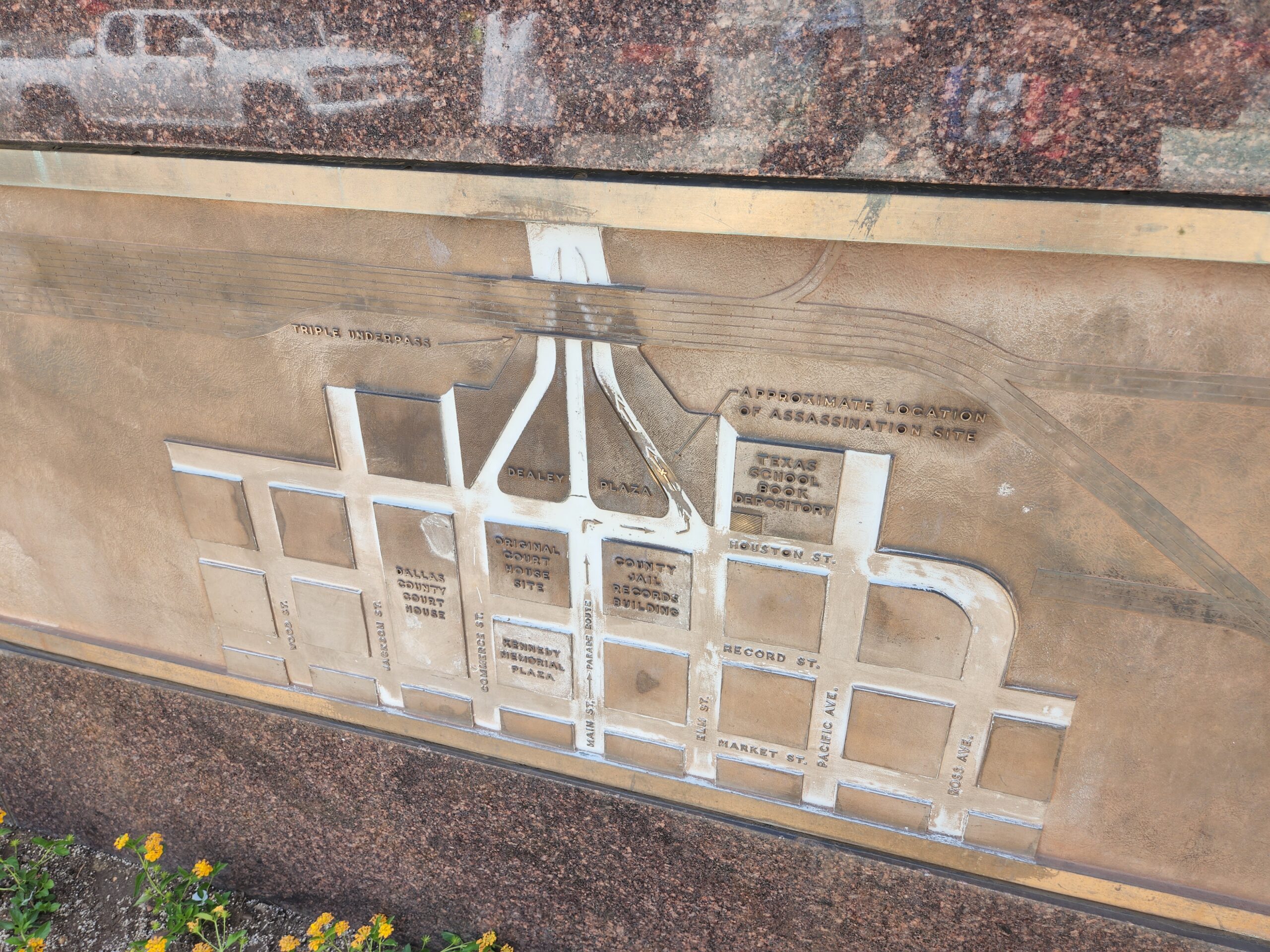
x
Despite forensic, ballistic, and eyewitness evidence supporting the official findings, public opinion polls have shown that most Americans still do not believe that the official version tells the whole truth of the events, and the assassination spawned numerous conspiracy theories.
A pesar de la evidencia forense, balística y de testigos oculares que respaldan los hallazgos oficiales, las encuestas de opinión pública han demostrado que la mayoría de los estadounidenses aún no cree que la versión oficial diga toda la verdad de los eventos y el asesinato generó numerosas teorías de conspiración.
Reunion Tower
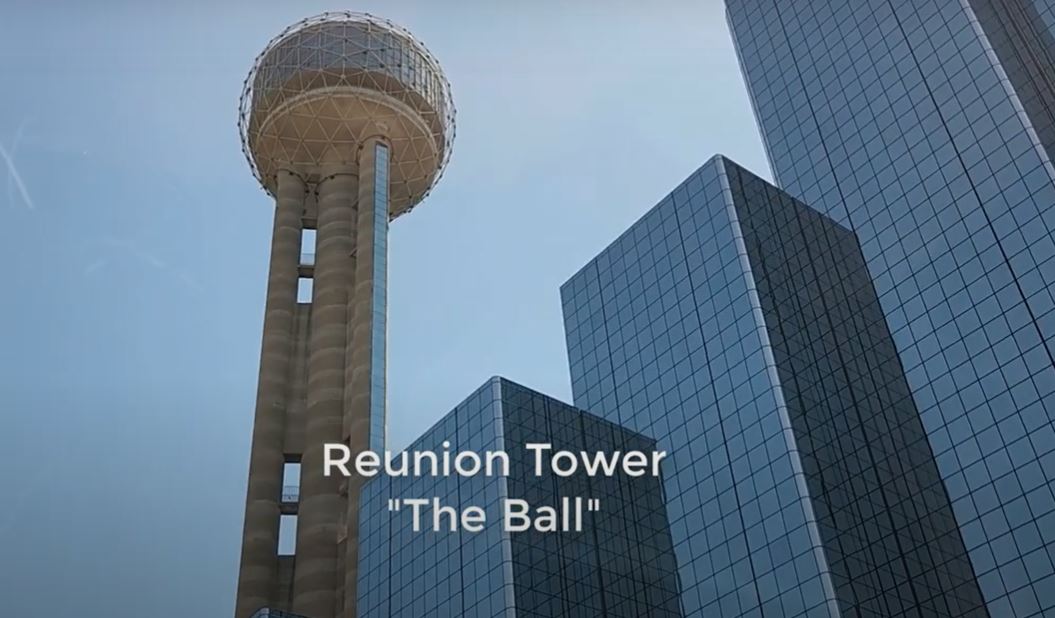
Reunion Tower, also known locally as “The Ball,” was completed on February 2, 1978, along with the Hyatt Regency Dallas at Reunion,[5] as part of an urban redevelopment project that also renovated the historic Union Station, which today services Amtrak, Dallas Area Rapid Transit, and the Trinity Railway Express to Dallas/Fort Worth International Airport and Fort Worth.
Reunion Tower, también conocida localmente como “The Ball”, se completó el 2 de febrero de 1978, junto con el Hyatt Regency Dallas en Reunion,[5] como parte de un proyecto de reurbanización urbana que también renovó la histórica Union Station, que hoy da servicio a Amtrak, Dallas Area Rapid Transit y trinity Railway Express al Aeropuerto Internacional de Dallas / Fort Worth y Fort Worth.
Henry C Beck Company was the tower’s Prime contractor. Also see HCB Contractors and The Beck Group Reunion Tower marks 35 years as Dallas landmark. When it first opened, the tower included radio station KOAX-FM, now KRLD-FM 105.3 FM, once owned by Westinghouse Broadcasting (“Live twenty-four hours a day from five-hundred feet above the city”). Because it is not used as a broadcast tower, it is not listed in the FCC Database.
Henry C Beck Company fue el contratista principal de la torre. También vea HCB Contractors y The Beck Group Reunion Tower marca 35 años como punto de referencia de Dallas. Cuando se abrió por primera vez, la torre incluía la estación de radio KOAX-FM, ahora KRLD-FM 105.3 FM, una vez propiedad de Westinghouse Broadcasting (“En vivo las veinticuatro horas del día desde quinientos pies sobre la ciudad”). Debido a que no se utiliza como torre de difusión, no aparece en la base de datos de la FCC.
Reunion Tower reopened its restaurant level on February 9, 2009, after it was closed for major renovations on November 16, 2007. The observation deck reopened October 5, 2013, just in time for the Tower’s 35th anniversary. The tower is located about 1,000 feet from Dealey Plaza and the site of the assassination of John F. Kennedy.
Reunion Tower reabrió su restaurante el 9 de febrero de 2009, después de que fue cerrado por renovaciones importantes el 16 de noviembre de 2007. La plataforma de observación reabrió el 5 de octubre de 2013, justo a tiempo para el 35 aniversario de la Torre. La torre se encuentra a unos 1.000 pies de Dealey Plaza y el sitio del asesinato de John F. Kennedy.
Bryan’s Cabin
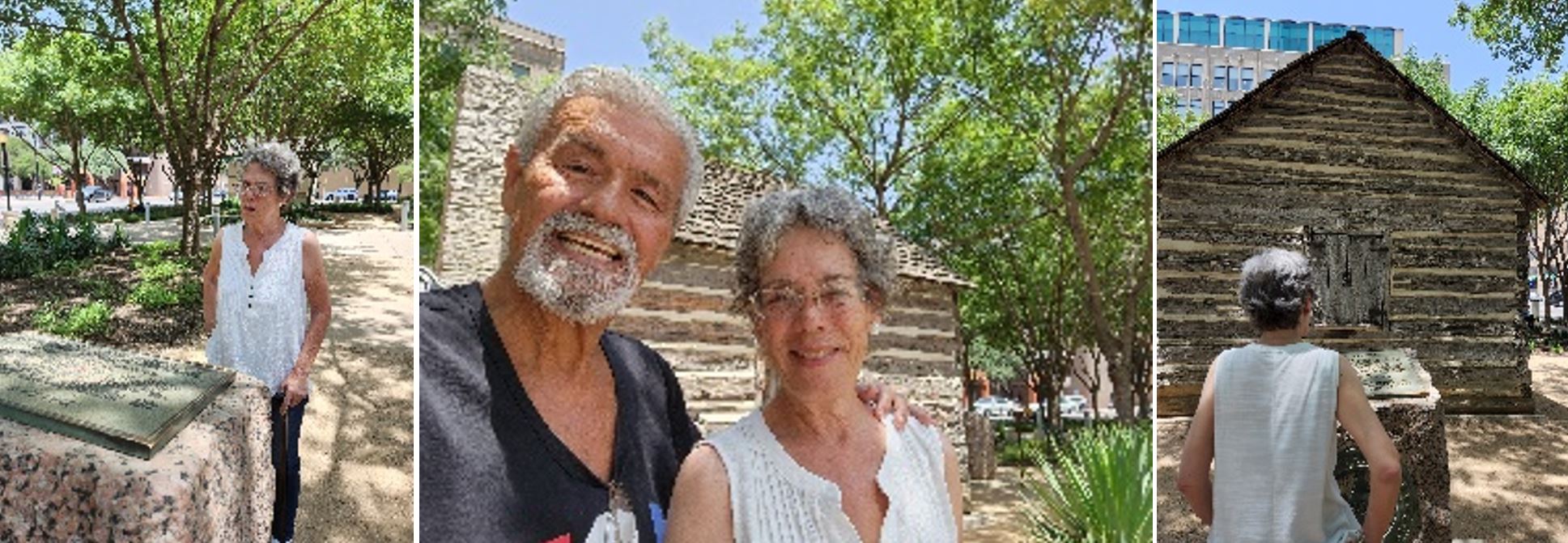
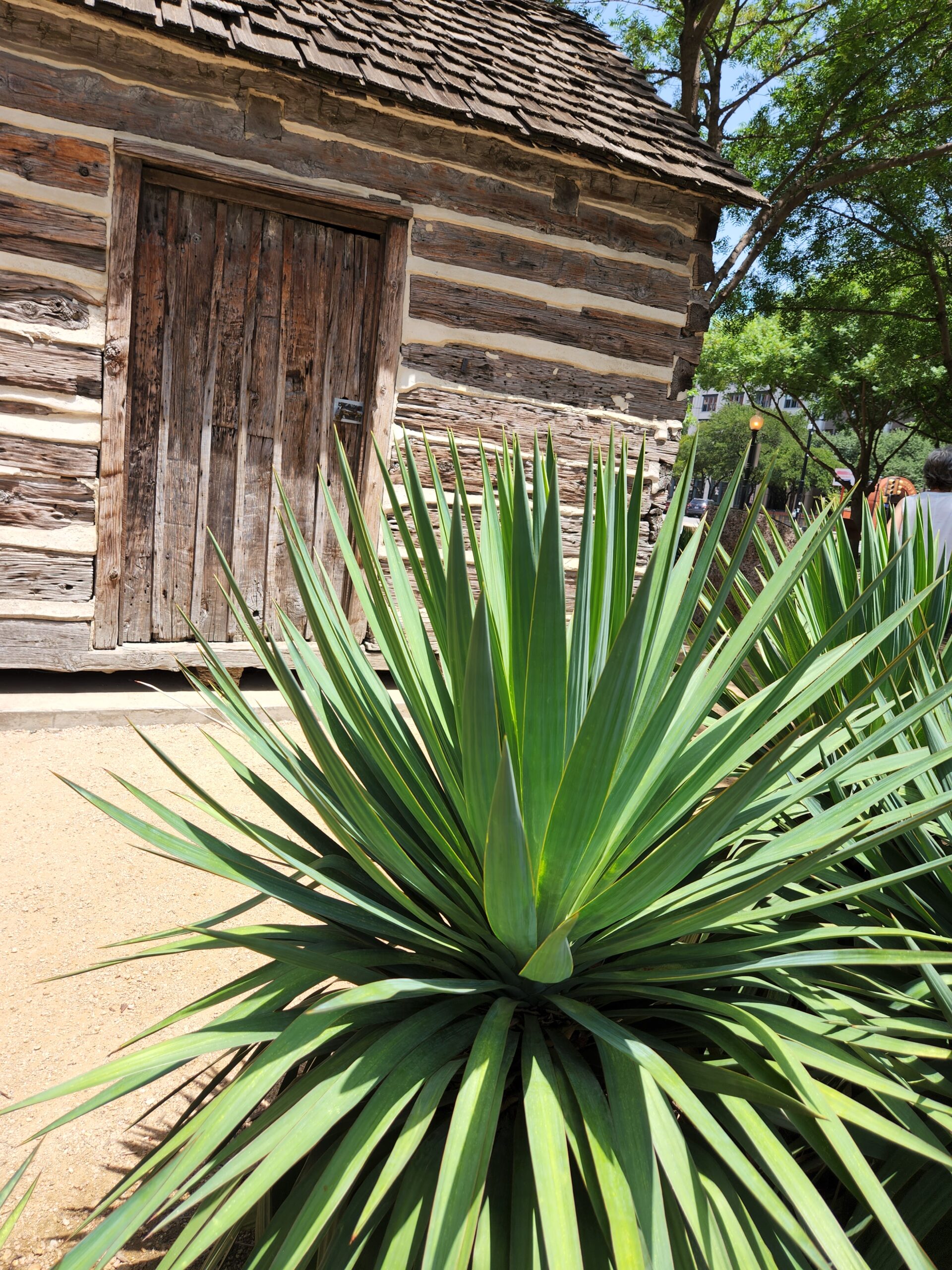
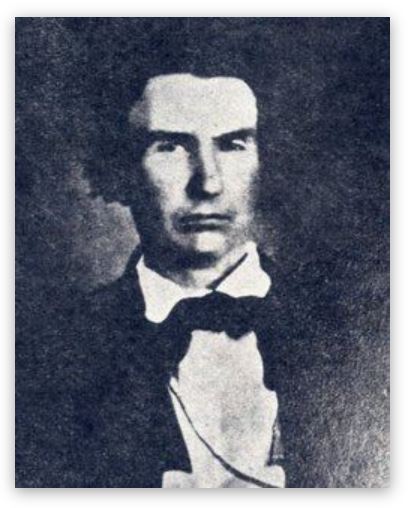
Bryan joined Col. Nicholas H. Darnell‘s Eighteenth Texas Cavalry regiment in the winter of 1861 and served with the unit until late 1862 when he was discharged due to his old age and poor health. He returned to Dallas in 1862 and again became actively involved in community affairs. In 1863, he was a trustee for the Dallas Male and Female Academy. In 1866, during a Dallas flood, he was very prominent in aiding those affected. He also chaired a citizens’ meeting that pushed the Houston and Texas Central Railway to complete the railway through the city and presided at a rally that sought to get full political rights for all ex-Confederates. In 1871 and 1872 Bryan became one of the directors of the Dallas Bridge Company, which built the first iron bridge across the Trinity River. He also stood on the platform at the welcoming ceremonies for the Houston and Texas Central Railway when the first train pulled into town in mid-July 1872.
x
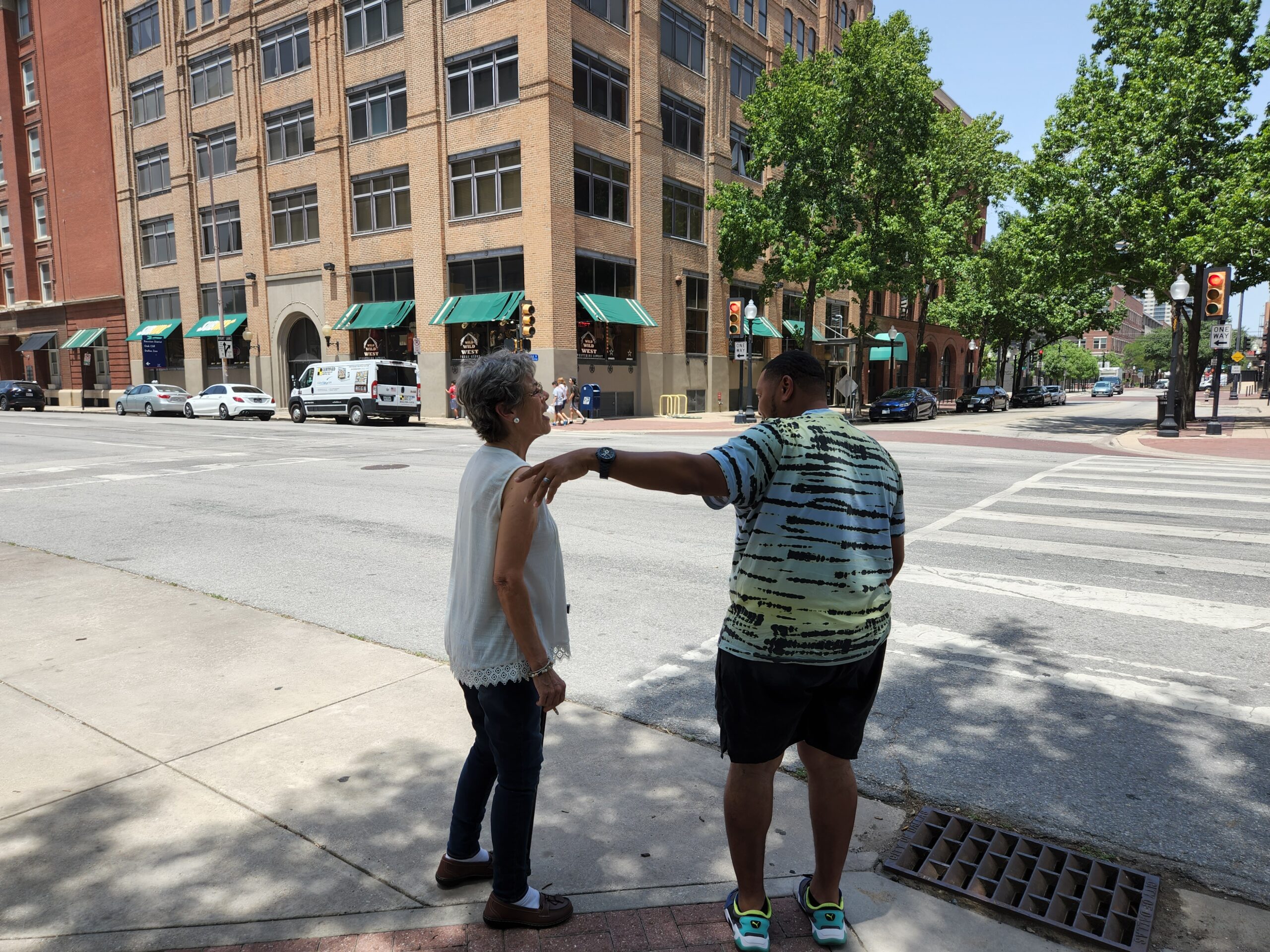
x
Siomi with Willie, our guide.
x
Bryan se unió al decimoctavo regimiento de caballería de Texas del coronel Nicholas H. Darnell en el invierno de 1861 y sirvió con la unidad hasta finales de 1862, cuando fue dado de baja debido a su vejez y mala salud. Regresó a Dallas en 1862 y nuevamente se involucró activamente en los asuntos comunitarios. En 1863, fue fideicomisario de la Academia Masculina y Femenina de Dallas. En 1866, durante una inundación en Dallas, fue muy prominente en ayudar a los afectados. También presidió una reunión de ciudadanos que empujó al Ferrocarril Central de Houston y Texas a completar el ferrocarril a través de la ciudad, y presidió un mitin que buscaba obtener plenos derechos políticos para todos los ex confederados. En 1871 y 1872 Bryan se convirtió en uno de los directores de la Dallas Bridge Company, que construyó el primer puente de hierro sobre el río Trinity. También se paró en la plataforma en las ceremonias de bienvenida para el Ferrocarril Central de Houston y Texas cuando el primer tren llegó a la ciudad a mediados de julio de 1872.
By 1874 Bryan’s mind was clearly impaired; though, it is not known exactly how. “I am the son of John Neely Bryan, now before the court,” Edward T. Bryan testified on Feb. 1, 1877. “My father is insane.” He was admitted to the Texas State Lunatic Asylum in February 1877 and died there on 8 September 1877. He is believed to be buried in an unmarked grave in the southeast quadrant of the Austin State Hospital Cemetery. In 2006, Bryan’s descendants placed a headstone in the cemetery that reads “PVT 18 Texas CAV CSA Dec 24, 1810, Sep 8, 1877, Founder of Dallas Texas.”
En 1874 la mente de Bryan estaba claramente deteriorada; sin embargo, no se sabe exactamente cómo. “Soy el hijo de John Neely Bryan, ahora ante la corte”, testificó Edward T. Bryan el 1 de febrero de 1877. “Mi padre está loco”. Fue admitido en el Asilo de Lunáticos del Estado de Texas en febrero de 1877 y murió allí el 8 de septiembre de 1877. “Mi padre está loco”. Fue admitido en el Asilo de Lunáticos del Estado de Texas en febrero de 1877 y murió allí el 8 de septiembre de 1877. Se cree que está enterrado en una tumba sin nombre en el cuadrante sureste del Cementerio del Hospital Estatal de Austin. En 2006, los descendientes de Bryan colocaron una lápida en el cementerio que dice “PVT 18 Texas CAV CSA 24 de diciembre de 1810 8 de septiembre de 1877 Fundador de Dallas Texas”.
In 1954, a white granite marker honoring the Dallas founder was erected by the James Butler Bonham chapter of the Daughters of the Republic of Texas in Pioneer Cemetery (Pioneer Plaza).
En 1954, un marcador de granito blanco en honor al fundador de Dallas fue erigido por el capítulo James Butler Bonham de las Hijas de la República de Texas en el Cementerio Pioneer (Pioneer Plaza).
A large marker bearing the name “Bryan” and displaying two “Citizen of the Republic of Texas” medallions honoring John Neely Bryan and his wife stands in Riverside Cemetery at Wichita Falls, Texas. It overlooks the graves of Margaret Beeman Bryan (1825-1919), her son John Neely Bryan, Jr. (1846-1926), and other family members.
Un gran marcador con el nombre “Bryan” y que muestra dos medallones de “Ciudadano de la República de Texas” en honor a John Neely Bryan y su esposa se encuentra en el cementerio Riverside en Wichita Falls, Texas. Tiene vistas a las tumbas de Margaret Beeman Bryan (1825-1919), su hijo John Neely Bryan, Jr. (1846-1926) y otros miembros de la familia.
A Texas Historical Marker “Beeman Memorial Cemetery,” located east of downtown Dallas just off of Dolphin Road, states that John Neely Bryan is buried in the Beeman family plot of his wife, Margaret, and other Beeman family members. This cemetery is somewhat hard to locate but is located just behind a large Jewish Cemetery (Shearith Israel) on Dolphin Road just south of Military Parkway.
Un marcador histórico de Texas “Beeman Memorial Cemetery”, ubicado al este del centro de Dallas, justo al lado de Dolphin Road, afirma que John Neely Bryan está enterrado en la parcela de la familia Beeman de su esposa, Margaret, y otros miembros de la familia Beeman. Este cementerio es algo difícil de localizar, pero se encuentra justo detrás de un gran cementerio judío (Shearith Israel) en Dolphin Road, justo al sur de Military Parkway.
The Bryan Pergola, standing on the Grassy Knoll in Dealey Plaza, Dallas, Texas, is named after John Neely Bryan (1810-1877), the recognized founder of the City of Dallas. Dallas Independent School District named an elementary school after him, John Neely Bryan Elementary.
La Pérgola Bryan, situada en el Grassy Knoll en Dealey Plaza, Dallas, Texas, lleva el nombre de John Neely Bryan (1810-1877), el reconocido fundador de la ciudad de Dallas. El Distrito Escolar Independiente de Dallas nombró a una escuela primaria en su honor, John Neely Bryan Elementary.
His Cabin

x
Replica of Dallas pioneer John Neely Bryan’s Log Cabin, now located in Founder’s Plaza in downtown Dallas. This is a reconstructed model of the home & trading post erected in 1841 by John Neely Bryan. A flood destroyed the original cabin. He founded Dallas in the early 1840’s & built a cabin near Trinity River in hopes of establishing & developing a permanent settlement in N. Texas. It is located at Elm & Market Street in Downtown Dallas, TX.
Una réplica de la cabaña de troncos del pionero de Dallas John Neely Bryan, ahora ubicada en Founder’s Plaza en el centro de Dallas. Este es un modelo reconstruido de la casa y el puesto comercial erigido en 1841 por John Neely Bryan. Una inundación destruyó la cabaña original. Fundó Dallas a principios de la década de 1840 y construyó una cabaña cerca de Trinity River con la esperanza de establecer y desarrollar un asentamiento permanente en el norte de Texas. Está ubicado en Elm & Market Street en el centro de Dallas, TX.
Cathedral
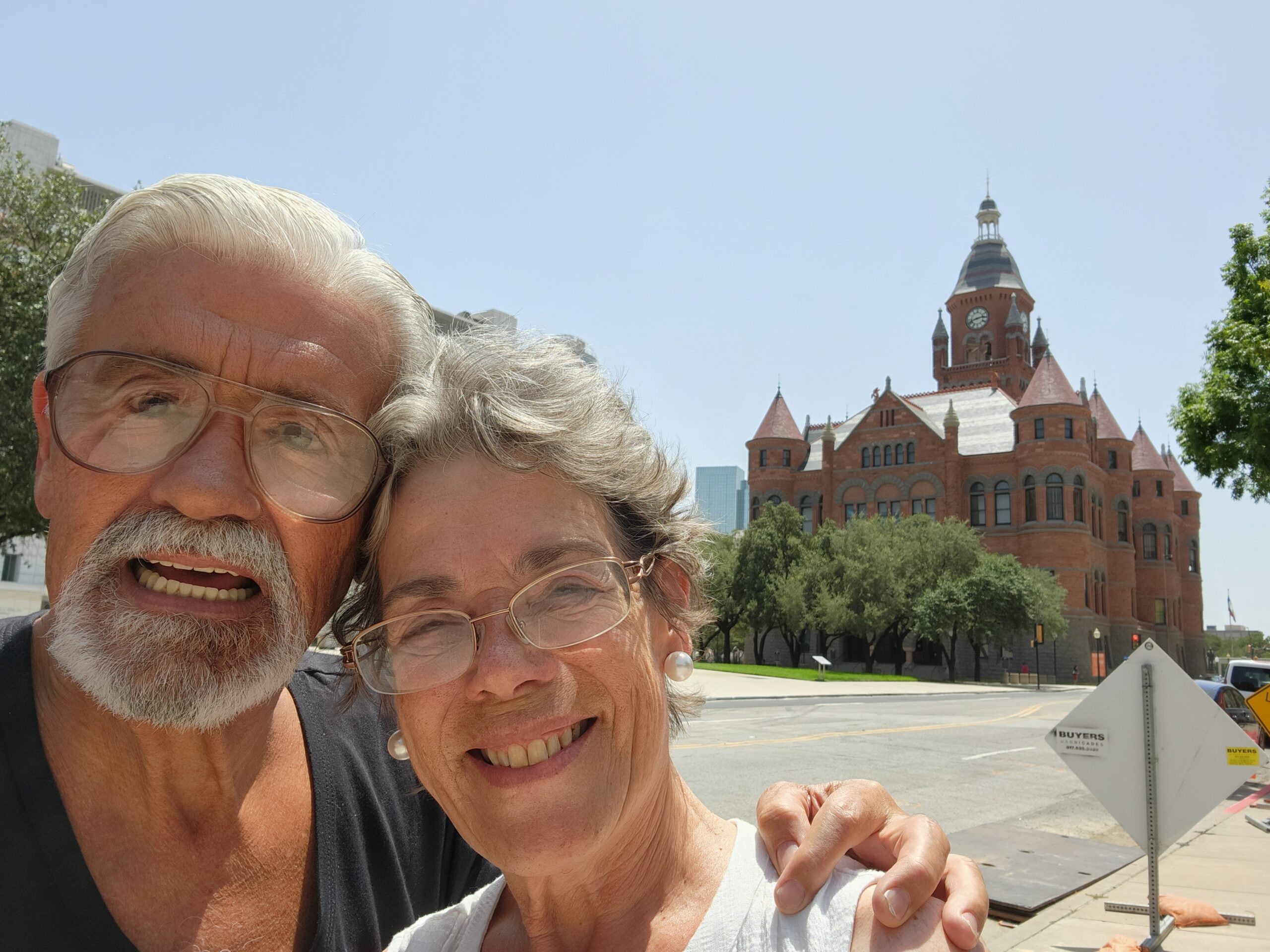
x
The Cathedral Santuario de la Virgen de Guadalupe (Cathedral Shrine of the Virgin of Guadalupe) is the cathedral church of the Roman Catholic Diocese of Dallas, Texas. The structure dates from the late 19th century and is located in the Arts District of downtown Dallas, Texas. The church oversees the second largest Catholic church membership in the United States. Its average Sunday attendance is 11,200.
La Catedral Santuario de la Virgen de Guadalupe es la iglesia catedral de la Diócesis Católica Romana de Dallas, Texas. La estructura data de finales del siglo 19 y se encuentra en el Distrito de las Artes del centro de Dallas, Texas. La iglesia supervisa la segunda membresía más grande de la iglesia católica en los Estados Unidos. Su asistencia dominical promedio es de 11.200.
In 1869, Dallas’s first Catholic parish, Sacred Heart Church, was established by the Bishop of Galveston. The church was built in 1872 and was located at Bryan and Ervay Streets, near present-day St. Paul Station.
En 1869, la primera parroquia católica de Dallas, la Iglesia del Sagrado Corazón, fue establecida por el obispo de Galveston. La iglesia fue construida en 1872 y estaba ubicada en las calles Bryan y Ervay, cerca de la actual estación de St. Paul.
x
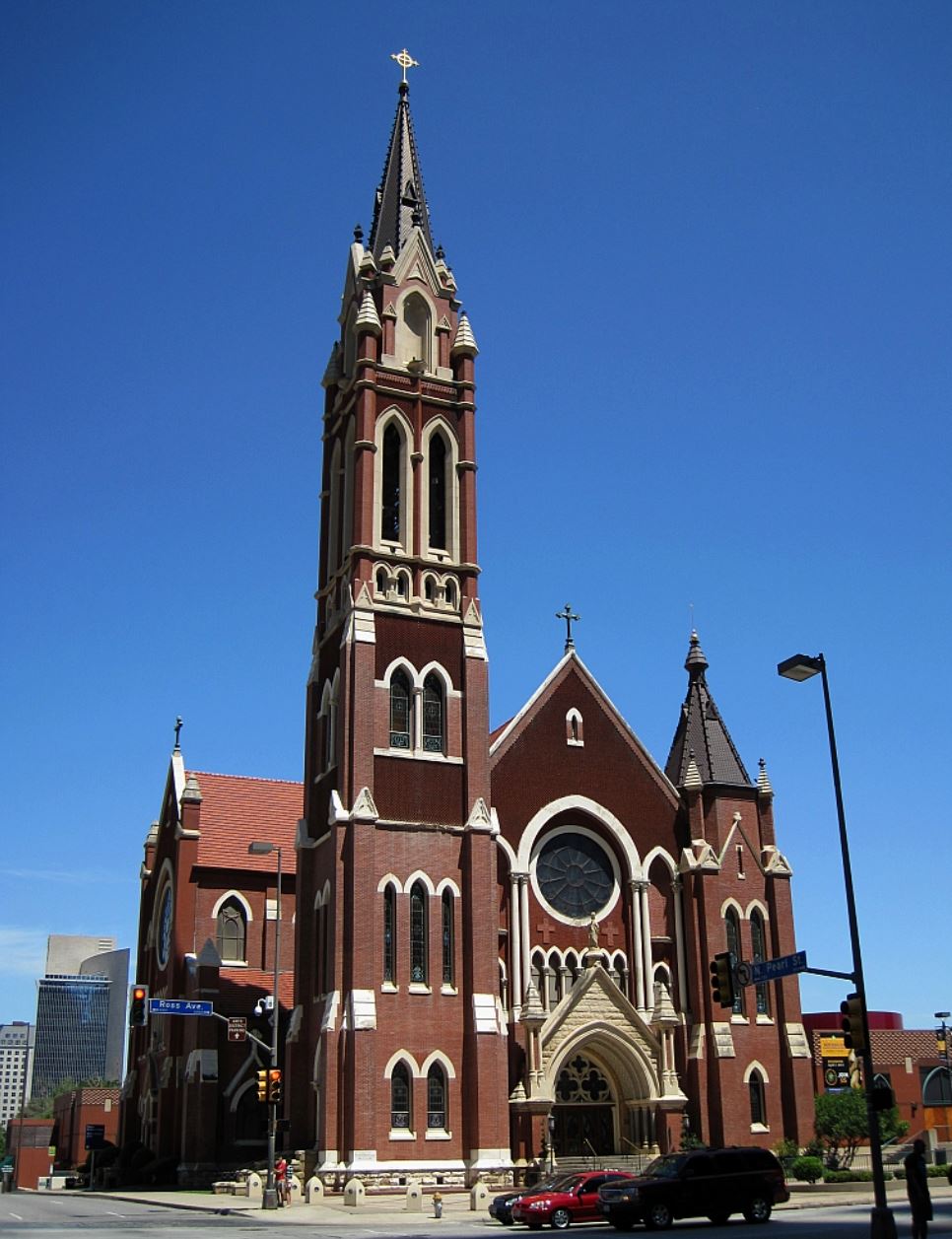
x
In 1890, Dallas was established as a diocese, and Sacred Heart became the diocesan cathedral of Dallas with Bishop Thomas Brennan acting as the first bishop. Along with Dallas’ tremendous growth at the time, the parish soon outgrew its church building, and the need for a new cathedral arose.
En 1890, Dallas se estableció como diócesis, y el Sagrado Corazón se convirtió en la catedral diocesana de Dallas con el obispo Thomas Brennan actuando como el primer obispo. Junto con el tremendo crecimiento de Dallas en ese momento, la parroquia pronto superó el edificio de su iglesia, y surgió la necesidad de una nueva catedral.
The property on which the current Cathedral is now located was purchased for US$30,000, which adjusted for inflation, is equivalent to over $600,000 in 2007. The cornerstone for the Cathedral was laid June 17, 1898 and the church was formally dedicated on October 26, 1902.
La propiedad en la que ahora se encuentra la catedral actual fue comprada por US $ 30,000, lo que ajustado por inflación, equivale a más de $ 600,000 en 2007. La piedra angular de la Catedral se colocó el 17 de junio de 1898 y la iglesia se dedicó formalmente el 26 de octubre de 1902.
Pegasus
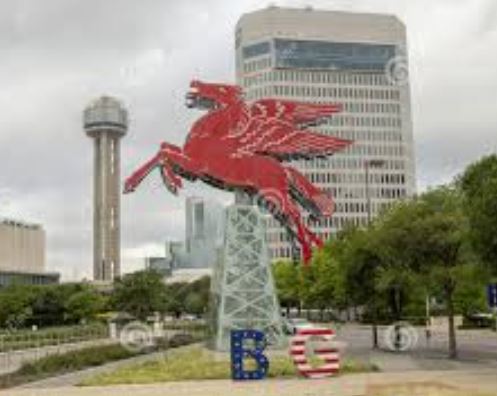
x
Over the years, the city of Dallas has become associated with a number of iconic images: a towering Big Tex, a lit-up Reunion Tower, a certain fictional oil tycoon and even a frozen margarita. Yet it’s Downtown Dallas’ resident flying horse, a pegasus, a mythical winged divine horse, and one of the most recognized creatures in Greek mythology. Usually, he is depicted as pure white. Myths about him vary as the Greek myths evolve and reflect progression through successive generations of deities. that has out-of-towners scratching their heads the most. What makes the red Pegasus so fascinating, and how has it become more than just another symbol of the greatness — real as well as imaginary — that defines Big D?
A lo largo de los años, la ciudad de Dallas se ha asociado con una serie de imágenes icónicas: un imponente Big Tex, una Torre de la Reunión iluminada, cierto magnate del petróleo ficticio e incluso una margarita congelada. Sin embargo, es el caballo volador o pegaso, un mítico caballo divino alado y una de las criaturas más reconocidas en la mitología griega, residente del centro de Dallas el que tiene a los forasteros rascándose más la cabeza. ¿Qué hace que el pegaso rojo sea tan fascinante, y cómo se ha convertido en algo más que otro símbolo de la grandeza, tanto real como imaginaria, que define a Big D?
The Pegasus first landed in Downtown Dallas in 1934, perching atop what was then the city’s tallest building: the 29-story Magnolia Hotel. A Greek mythological symbol of wealth, power and fame, the Pegasus was given the responsibility of extending a special welcome to guests attending the American Petroleum Institute’s annual meeting. In fact, the Magnolia was originally crowned with not one but two Pegasuses, leading many to speculate that the construction was a sly nod to Dallas being more than a one-horse town.
El pegaso aterrizó por primera vez en el centro de Dallas en 1934, encaramado en lo alto de lo que entonces era el edificio más alto de la ciudad: el Magnolia Hotel de 29 pisos. Un símbolo mitológico griego de riqueza, poder y fama, el pegaso recibió la responsabilidad de extender una bienvenida especial a los invitados que asistieron a la reunión anual del American Petroleum Institute. De hecho, la Magnolia fue coronada originalmente con no uno, sino dos pegasos, lo que llevó a muchos a especular que la construcción era un guiño astuto a Dallas a ser más que una ciudad de un solo caballo.
It’s safe to say the Pegasus fulfilled its promise. Dallas continued to boom throughout the 20th century, thanks in large part to the oil industry. For six decades following its first appearance, the red neon outline of the Pegasus flew over the city’s skyline. It’s even been reported that this unique beacon was bright and distinctive enough to direct airline pilots toward Love Field.
Es seguro decir que el pegaso cumplió su promesa. Dallas continuó en auge a lo largo del siglo 20, gracias en gran parte a la industria petrolera. Durante seis décadas después de su primera aparición, el contorno de neón rojo del pegaso voló sobre el horizonte de la ciudad. Incluso se ha informado que este faro único era lo suficientemente brillante y distintivo como para dirigir a los pilotos de aerolíneas hacia Love Field.
But even time and the elements take their toll on an icon. In 2000, severe weathering necessitated that the original Pegasus be replaced with a shiny new upgrade. Unfortunately, in the process, that historic sign became lost. It was more than a decade later (2015) before it was rediscovered in the dark of a storage facility near White Rock Lake. This Pegasus has since been renovated and now sits in an outdoor plaza at the entrance to the Omni Dallas Hotel. Even in the 21st century, the Pegasus continues to fulfill its first mission — welcoming visitors to Dallas.
Pero incluso el tiempo y los elementos pasan factura a un icono. En 2000, el clima severo requirió que el Pegasus original fuera reemplazado por una nueva actualización brillante. Desafortunadamente, en el proceso, ese signo histórico se perdió. Fue más de una década después (2015) antes de que fuera redescubierto en la oscuridad de una instalación de almacenamiento cerca de White Rock Lake. Este Pegasus ha sido renovado desde entonces y ahora se encuentra en una plaza al aire libre en la entrada del Omni Dallas Hotel. Incluso en el siglo 21, el Pegasus continúa cumpliendo su primera misión: dar la bienvenida a los visitantes a Dallas.
But even more lasting than the physical structure itself are the memories associated with the Pegasus, particularly for older residents. Ask many long-time Dallasites and they will tell you that Downtown was never as vibrant or prosperous a neighborhood than in the days when the neon sign’s red glow was the most brilliant aspect of the city’s night sky.
Pero aún más duraderos que la estructura física en sí son los recuerdos asociados con el pegaso, particularmente para los residentes mayores. Pregúntele a muchos habitantes de Dallas desde hace mucho tiempo y le dirán que el centro de la ciudad nunca fue un vecindario tan vibrante o próspero como en los días en que el resplandor rojo del letrero de neón era el aspecto más brillante del cielo nocturno de la ciudad.
Although some things have changed, the symbol lives on. In fact, it’s hard to travel even a mile without stumbling on some version of or tribute to the Pegasus. A majestic, winged horse currently serves as the mascot for both the Booker T. Washington High School for the Performing and Visual Arts and the Dallas Wings WNBA team. There’s a Pegasus Plaza on Main Street and Pegasus Banks throughout the city. And don’t forget Pegasus City Brewery, Pegasus Theatre, Pub Pegasus, Red Pegasus Comics.
Aunque algunas cosas han cambiado, el símbolo sigue vivo. De hecho, es difícil viajar incluso una milla sin tropezar con alguna versión o tributo al pegaso. Un majestuoso caballo alado actualmente sirve como mascota tanto para la Booker T. Washington High School for the Performing and Visual Arts como para el equipo Dallas Wings WNBA. Hay una Plaza Pegasus en Main Street y Pegasus Banks en toda la ciudad. Y no te olvides de Pegasus City Brewery, Pegasus Theatre, Pub Pegasus, Red Pegasus Comics.
Mandalay Canal
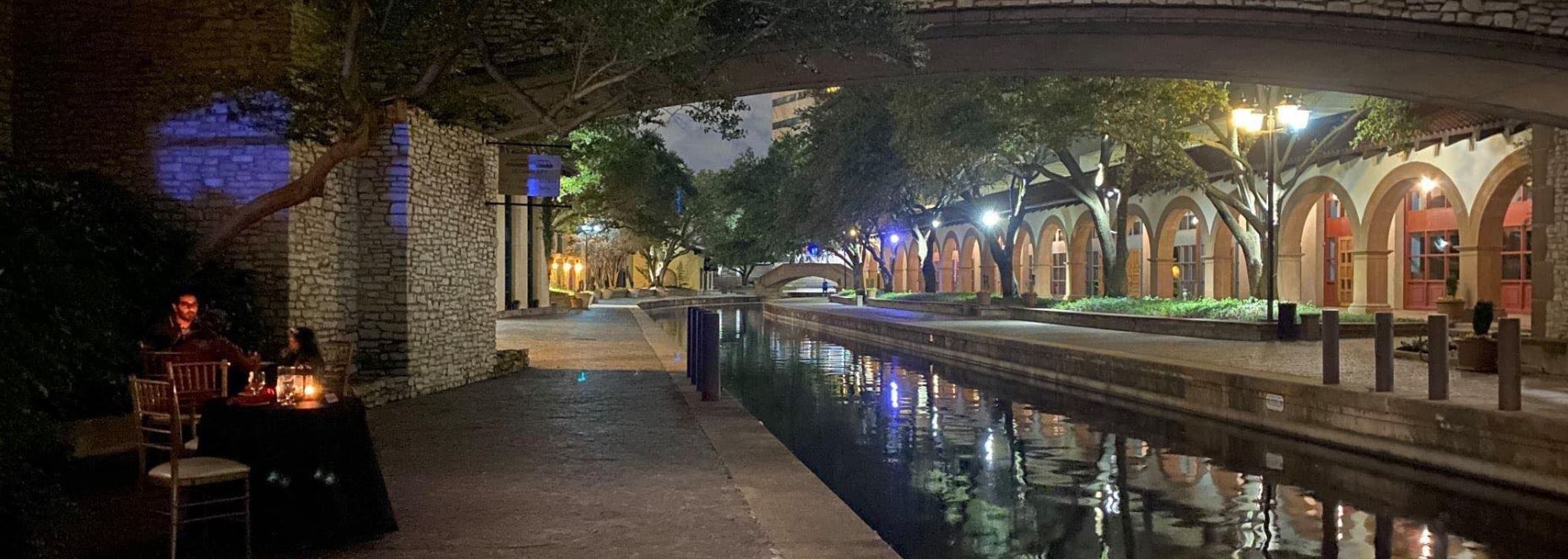

The canals are tucked into a small area in Las Colinas. It’s a completely hidden gem and not many people even know it exists! I highly recommend you check it out for those important photoshoots.
Pioneer Plaza
Today the park is maintained by the adjacent Dallas Convention Center and is the second most visited tourist attraction in downtown Dallas. As a work in progress, an additional steer is occasionally added to the herd.
Hoy en día, el parque es mantenido por el adyacente Centro de Convenciones de Dallas y es la segunda atracción turística más visitada en el centro de Dallas. Como trabajo en progreso, ocasionalmente se agrega un novillo adicional a la manada.
The large sculpture commemorates nineteenth century cattle drives that took place along the Shawnee Trail, the earliest and easternmost route by which Texas longhorn cattle were taken to northern railheads. The trail passed through Austin, Waco, and Dallas until the Chisolm Trail siphoned off most of the traffic in 1867. The 49 bronze steers and 3 trail riders’ sculptures were created by artist Robert Summers of Glen Rose, Texas. Each steer is larger-than-life at six feet high; all together the sculpture is the largest bronze monument of its kind in the world. Set along an artificial ridge and past a man-made limestone cliff, native landscaping with a flowing stream and waterfall help create the dramatic effect.
Farmers Market
The Dallas Farmers Market is a large public market located at 1010 S. Pearl Expressway in the Farmers Market District of downtownDallas, Texas.
El Dallas Farmers Market es un gran mercado público ubicado en 1010 S. Pearl Expressway en el Farmers Market District del centro de Dallas, Texas.
x
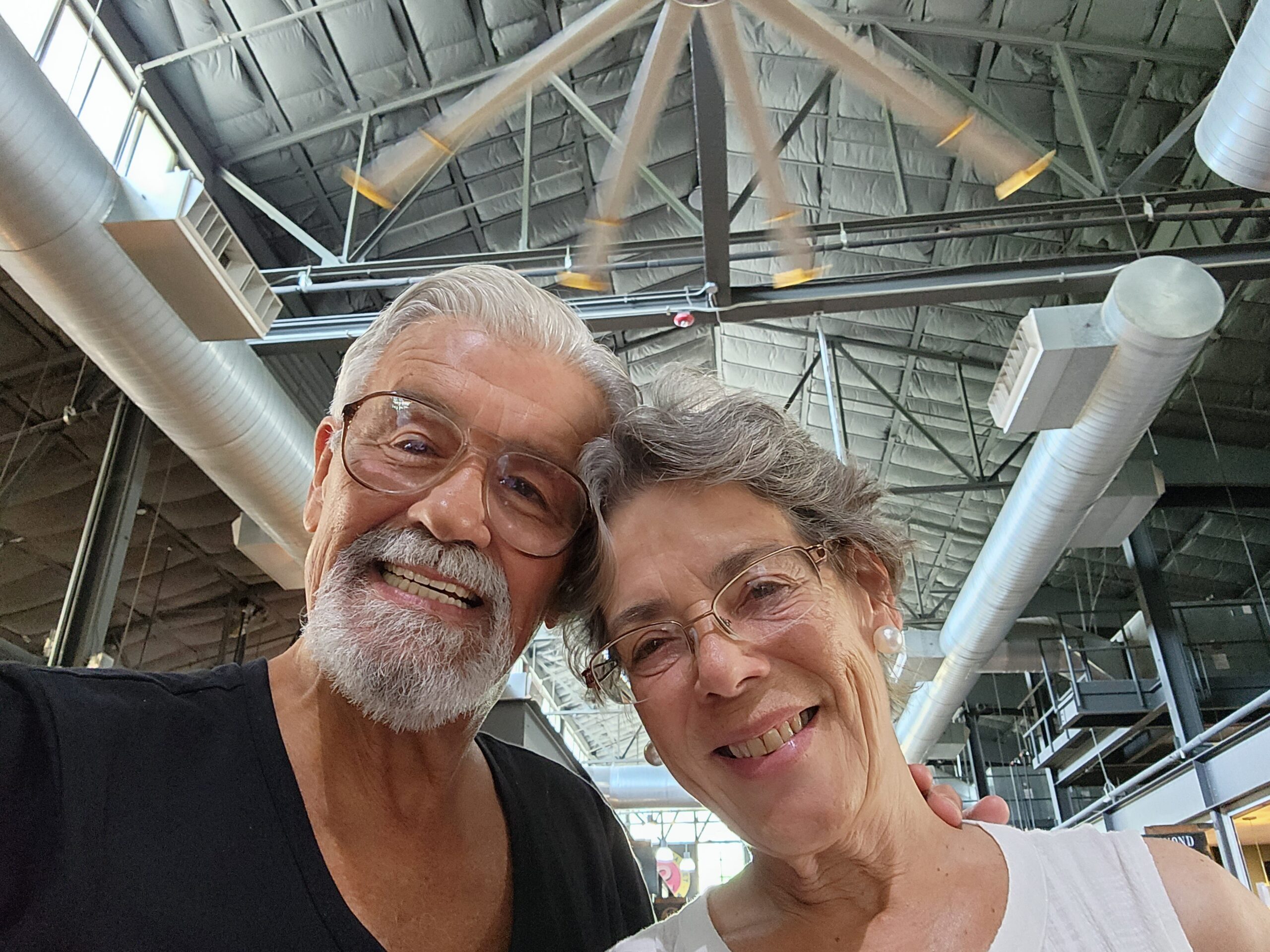
x
Siomi and I in Dallas’ Farmers Market
x
Today, the Dallas Farmers Market features three kinds of sellers: produce dealers, wholesale dealers and local farmers. Monthly yard sales, cooking classes, workshops, and seasonal festivals also take place throughout the year. Floral and garden vendors are located adjacent to the market.
Hoy en día, el Dallas Farmers Market cuenta con tres tipos de vendedores: distribuidores de productos, distribuidores mayoristas y agricultores locales. Las ventas mensuales de patio, las clases de cocina, los talleres y los festivales de temporada también se llevan a cabo durante todo el año. Los vendedores de flores y jardines se encuentran junto al mercado.
For several years, the Dallas City Council Economic Development Committee has been in talks with developers. In early December 2013, plans were announced (subject to approval) for mixed-use residential and retail redevelopment of the area. Announced plans include tearing down Sheds 3 & 4, replacing them with retail space and roughly 300 residential units, and converting Shed 2 entirely to retail and a food pavilion. Shed 1, the only property still owned by the city, will house the remaining actual farmer’s market, with an expected doubling of the number of stalls available to local farmers.
Durante varios años, el Comité de Desarrollo Económico del Concejo Municipal de Dallas ha estado en conversaciones con los desarrolladores. A principios de diciembre de 2013, se anunciaron planes (sujetos a aprobación) para la reurbanización residencial y minorista de uso mixto de la zona. Los planes anunciados incluyen derribar Sheds 3 y 4, reemplazarlos con espacio comercial y aproximadamente 300 unidades residenciales, y convertir Shed 2 por completo en tiendas minoristas y un pabellón de alimentos. El cobertizo 1, la única propiedad que aún es propiedad de la ciudad, albergará el mercado de agricultores real restante, con una duplicación esperada del número de puestos disponibles para los agricultores locales.
x
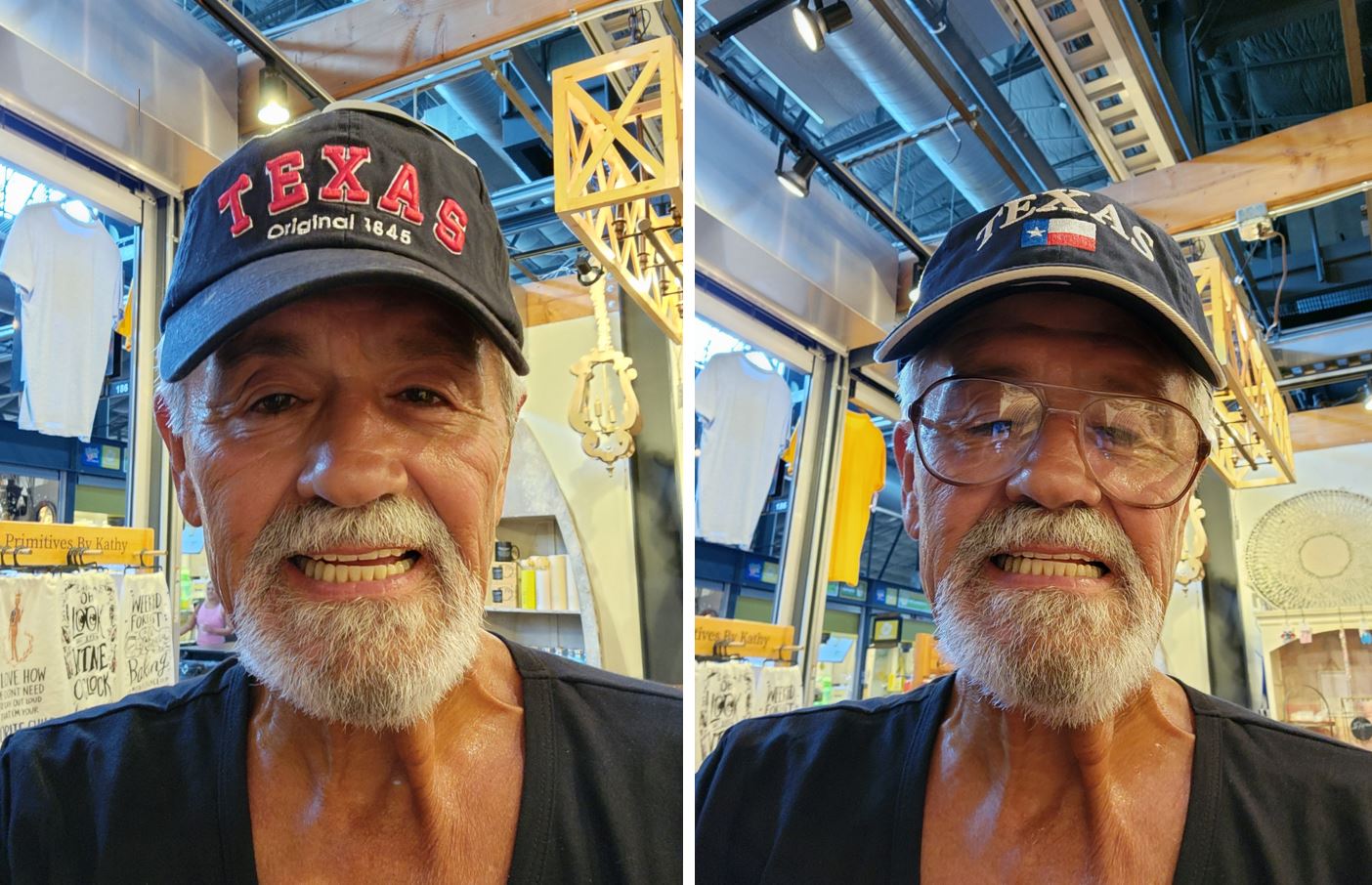
x
Trying on caps at the Farmers Market in Dallas
x
We went to this place thinking about something else. It turned out to be one of the 6 disappointments of our trip. It is actually a small shopping center with shops for tourists and fast food restaurants and fifth category. Although the comparisons are odious, we couldn’t help but compare Dallas’ “Farmers Market” to Hollywood, Florida, located a few miles from our home. The video below speaks for itself.
Fuimos a este lugar pensando en otra cosa. Resultó ser una de las 6 decepciones de nuestro viaje. En realidad se trata de un pequeño centro comercial con tiendas para los turistas y restaurantes de comida rápida y de quinta categoría. Aunque las comparaciones son odiosas, no pudimos evitar comparar el “Farmers Market” de Dallas con el de Hollywood, en Florida, ubicado a pocas millas de nuestro hogar. El video de abajo habla por sí solo.
Hollywood Farmers Market
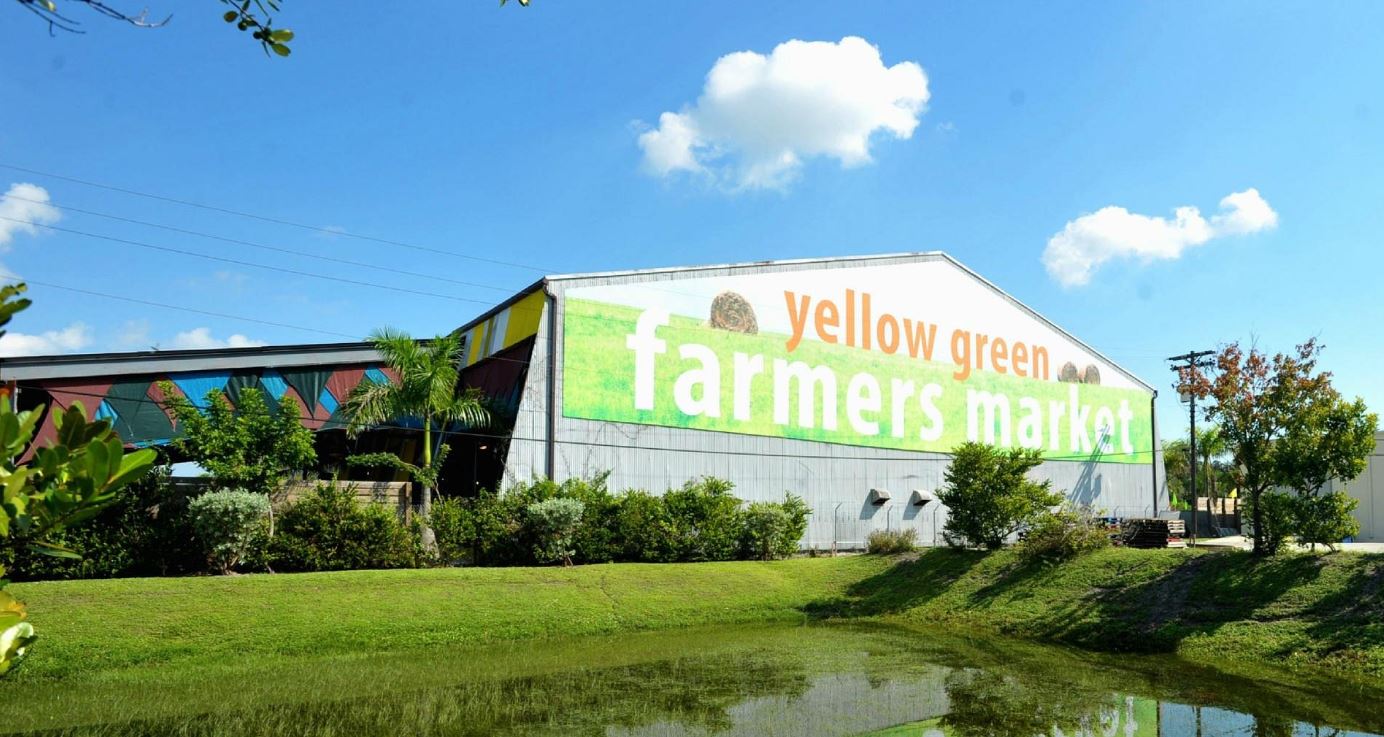
Estafa
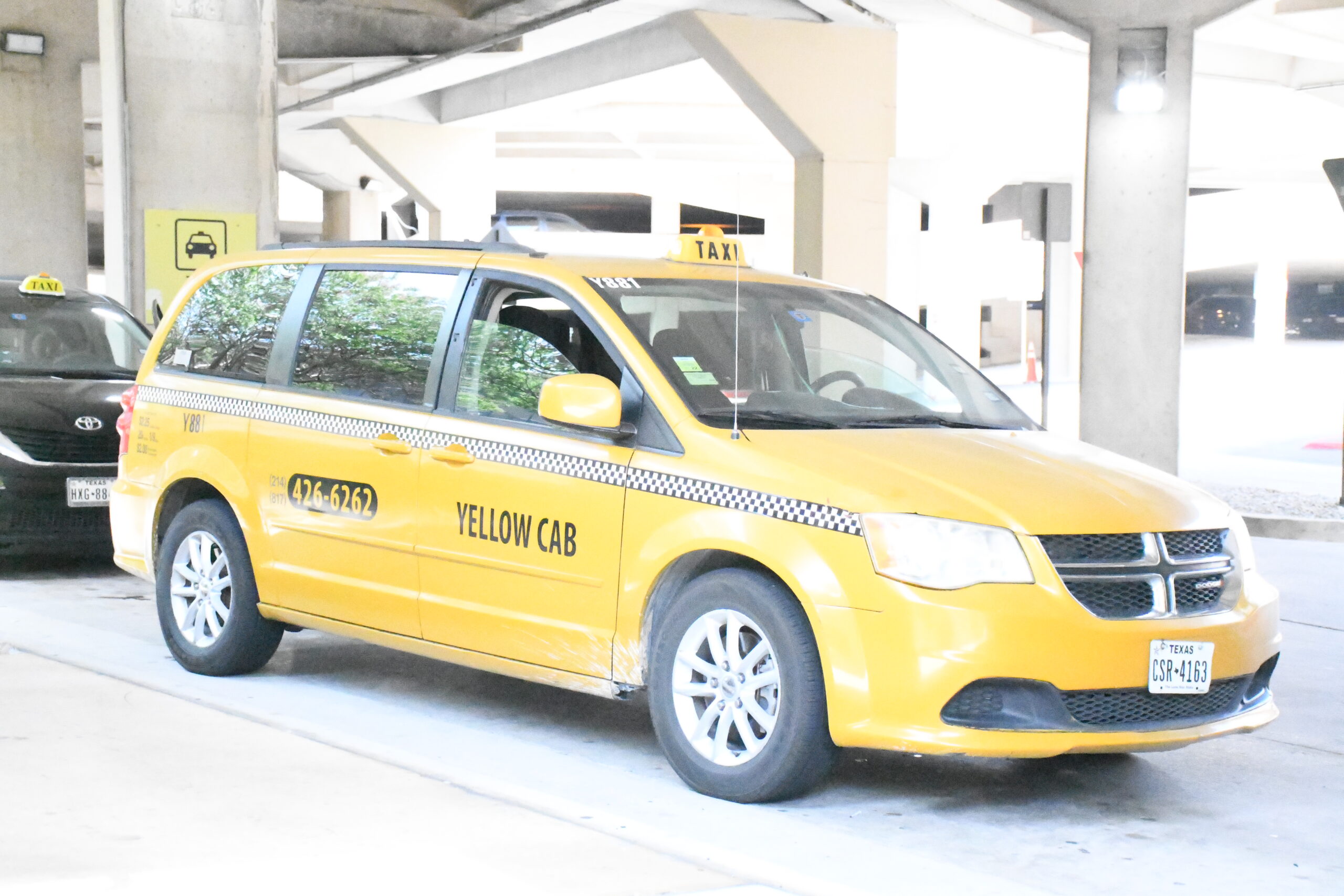
Index
| 1st Street Restaurante de Deer Park …..Eating Prime Ribs …..Mark & the story of the Bread Board …..Hay bales …..Hay roles …..Harold Weger | ||||||||||||||||||||||||||
| ||||||||||||||||||||||||||
Index of our trips |

